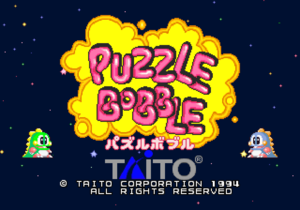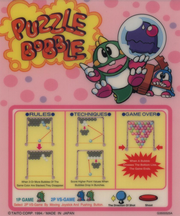Lost In Translation/Puzzle Bobble
| Puzzle Bobble | |
|---|---|
| Manufacturer | Taito Corporation |
| Released | 1994 |
| Control Method |
8-way Joystick 3 Button(s) |
| Main CPU | 68000 (@ 12.000 MHz) Z80 (@ 4.000 MHz) |
| Sound CPU | Mono YM2610B (@ 8.000 MHz) |
| Video Details |
Raster (Horizontal) 320 x 224 pixels 60.00 Hz 4,096 Palette colours |
| Screens | 1 |
| ROM Info | 6 ROMs 2,752,512 bytes (2.63 MiB) |
| MAME ID | pbobble |
About The Game
Puzzle Bobble, as its name implies, is an arcade video puzzle game.
The first in the hugely successful puzzle series from Taito, Puzzle Bobble is a game for 1 or 2 players in which the aim is to clear each play area of the coloured bubbles that litter it. This is achieved by firing bubbles up the screen - with the angle of trajectory dictated by the player - at the clusters of static coloured bubbles that litter each play area. The aim is to forms chains of like-coloured bubbles, thus making them disappear. At regular intervals, the bubbles will drop one row down the screen, making life more difficult for the players. The game is over when the bubbles reach the very bottom of the play area.
In the 1-player game there are thirty rounds to complete, whereas in the 2-player Vs. mode, the winner is the player who clears their play area first. The addictive yet straightforward game-play mechanic ensured that the "Puzzle Bobble" games would be the most successful of their genre since Russian programmer, Alexey Pajitnov's legendary "Tetris" was unleashed upon the gaming world in the late 1980s.
Trivia
Released in June 1994.
The game was originally called "Bubble Buster". The Bubble Buster title screen is buried in the game itself.
This game is known in US as "Bust-A-Move".
This game was re-released 6 months later (December 1994) on the SNK Neo-Geo MVS hardware as "Puzzle Bobble [MVS]".
As well as typically cute Japanese animation (the characters from "Bubble Bobble" operate the cannon) and music, the game's mechanics and level design were beautifully balanced, and the game was terrifically successful at the arcades, spawning several sequels (see Series section for more information). It is unusual in being popular with women and girls.
If you look closely at the bubbles, you'll notice that the enemies from "Bubble Bobble" are trapped inside; a different enemy for each different coloured bubble. The following chart shows which enemies are trapped in which colour bubble :
| Colour of bubble | Bubble Bobble enemy inside |
|---|---|
| Blue | Zen-Chan |
| Yellow | Pulpul |
| Red | Invader |
| Green | Drunk |
| Purple | Monsta |
| Orange | Banebou |
| Black | Hidegonsu |
| White | Mighta |
The game forbids the initials 'SEX' on the high score table. If you try, it gets changed to 'AAA'.
During the credits you can see one of the constellations form the image of a fish, that fish is a boss from the "Darius" series; also made by Taito.
Stepehn Krogman holds the official records for this game with 13,874,390 points (difficulty 6) on 06/11/2004.
Zuntata Records released a limited-edition soundtrack album for this game (Puzzle Bobble Variety - ZTTL-0009) on 28/03/1997.
Scoring
Pop bubbles of the same colour, each bubble is worth 10 points. When dropping bubbles, the first bubble is 20, and each additional bubble scores double, thus:
| Bubbles dropped | Points |
|---|---|
| 1 | 20 |
| 2 | 40 |
| 3 | 80 |
| 4 | 160 |
| 5 | 320 |
| 6 | 640 |
| 7 | 1,280 |
| 8 | 2,560 |
| 9 | 5,120 |
| 10 | 10,240 |
| 11 | 20,480 |
| 12 | 40,960 |
| 13 | 81,920 |
| 14 | 163,840 |
| 15 | 327,680 |
| 16 | 655,360 |
| 17 or more | 1,310,720 |
Bonus points are awarded based on how fast you completed the stage.
| Seconds | Points |
|---|---|
| 0-5 | 50,000 |
| 6 | 49,160 |
| 7 | 48,320 |
| 8 | 47,480 |
| 9 | 46,640 |
| 10 | 45,800 |
| ... | |
| 64 | 440 |
| 65+ | NO BONUS |
Tips and tricks
There is a special bonus of a million points on rounds 9 and 13. This is achieved by linking up a number of ORANGE bubbles on round 9 and BLUE bubbles on round 13.
Series
- Puzzle Bobble (1994)
- Puzzle Bobble [MVS] (1994)
- Puzzle Bobble 2 (1995)
- Puzzle Bobble 2 [MVS] (1999)
- Puzzle Bobble 2X (1995)
- Puzzle Bobble 3 (1996)
- Puzzle Bobble 4 (1997)
- Super Puzzle Bobble (1999)
- Azumanga Daioh Puzzle Bobble (2002)
- Super Puzzle Bobble 2 (2002, Sony PlayStation 2)
- Super Puzzle Bobble All-Stars (2003, Nintendo GameCube)
- Puzzle Bobble Vs. (2003, Nokia N-Gage)
- Ultra Bust-a-Move (2004, Microsoft XBOX)
- Puzzle Bobble Pocket (2005, Sony PSP)
- Puzzle Bobble DS (2005, Nintendo DS)
Staff
- Game Designer
- Seiichi Nakakuki
- Programmer & Game Designer
- Tkhc.02
- Programmer & System Designer
- Tmr
- Programmer & Play Designer
- Nob
- Character & Game Designer
- Kazuhiro Kinoshita
- Character Designers
- Komai Ryota
- Miwa Kamiya
- Music Composed By
- Kazuko Umino
- Yasuko Yamada
- Sound Effects
- Hideki Takahagi
- Sound Soft
- Naoto Yagishita
- Sound Producer
- Hiroshige Tonomura
- Designers
- Hiroyasu Nagai (Super Star Nagai)
- T. Yoshiba
- M. Osaka
- Nobuaki Kuroki
- Y. Onogi
- Supervisors
- Masaki Yagi
- T. Saito
- G Rox
- H. Kato
- K. Tajima
Cabinet and Artwork
Ports
- Consoles
- Nintendo Super Famicom (1995)
- SNK Neo-Geo CD (1995)
- Panasonic 3DO (1995)
- Sega Game Gear (1995, "Bust-A-Move")
- Nintendo Game Boy (1998, "Puzzle Bobble GB")
- SNK Neo-Geo Pocket (1999, Puzzle Bobble Mini")
- Bandai WonderSwan (1999)
- Computers
- PC [MS Windows 95, CD-ROM] (1996)
- Other
- SNK Neo-Geo Arcade (1994)
Soundtrack Releases
| Album Name | Catalogue No. | Released | Publisher | Comments |
|---|---|---|---|---|
| Puzzle Bobble Variety | ZTTL-0009[1] | 1997-03-28 | Zuntata Records | CD version. |
| ZUNTATA LIVE 1998 "güten Talk" from the earth ~AUDIO FILE~ | ZTTL-0031[2] | 1998-10-21 | Zuntata Records | 2 CD version. |
| ZUNTATA LIVE 1998 "güten Talk" from the earth ~VISUAL FILE~ | N/A[3] | 1998-11-10 | Zuntata Records | Released on VHS. |
| ZUNTATA HISTORY L'ab-normal 2nd | ZTTL-0039[4] | 1999-04-01 | Zuntata Records | CD version. |
| PUZZLE BOBBLE • GEKIRINDAN etc. ~Welcome to the Karuland~ | PCCB-00196[5] | 1995-11-17 | Pony Canyon/Scitron | CD version. |
Sound Comparison
| Platform | Song Titles | Sound Source | ||||||
|---|---|---|---|---|---|---|---|---|
| Arcade | "Title Demo" | "Let's Go To Pao Pao Island! (BGM1)" | "Forest In April (BGM2)" | "Clear" | "Continue" | "Ending" | "Game Over" | M1 v0.7.8a6 |
References
- ↑ Puzzle Bobble Variety (CD) at the VGMdb
- ↑ ZUNTATA LIVE 1998 "güten Talk" from the earth ~AUDIO FILE~ (CD) at the VGMdb
- ↑ ZUNTATA LIVE 1998 "güten Talk" from the earth ~VISUAL FILE~ (VHS) at the VGMdb
- ↑ ZUNTATA HISTORY L'ab-normal 2nd (CD) at the VGMdb
- ↑ PUZZLE BOBBLE • GEKIRINDAN etc. ~Welcome to the Karuland~ (CD) at the VGMdb







